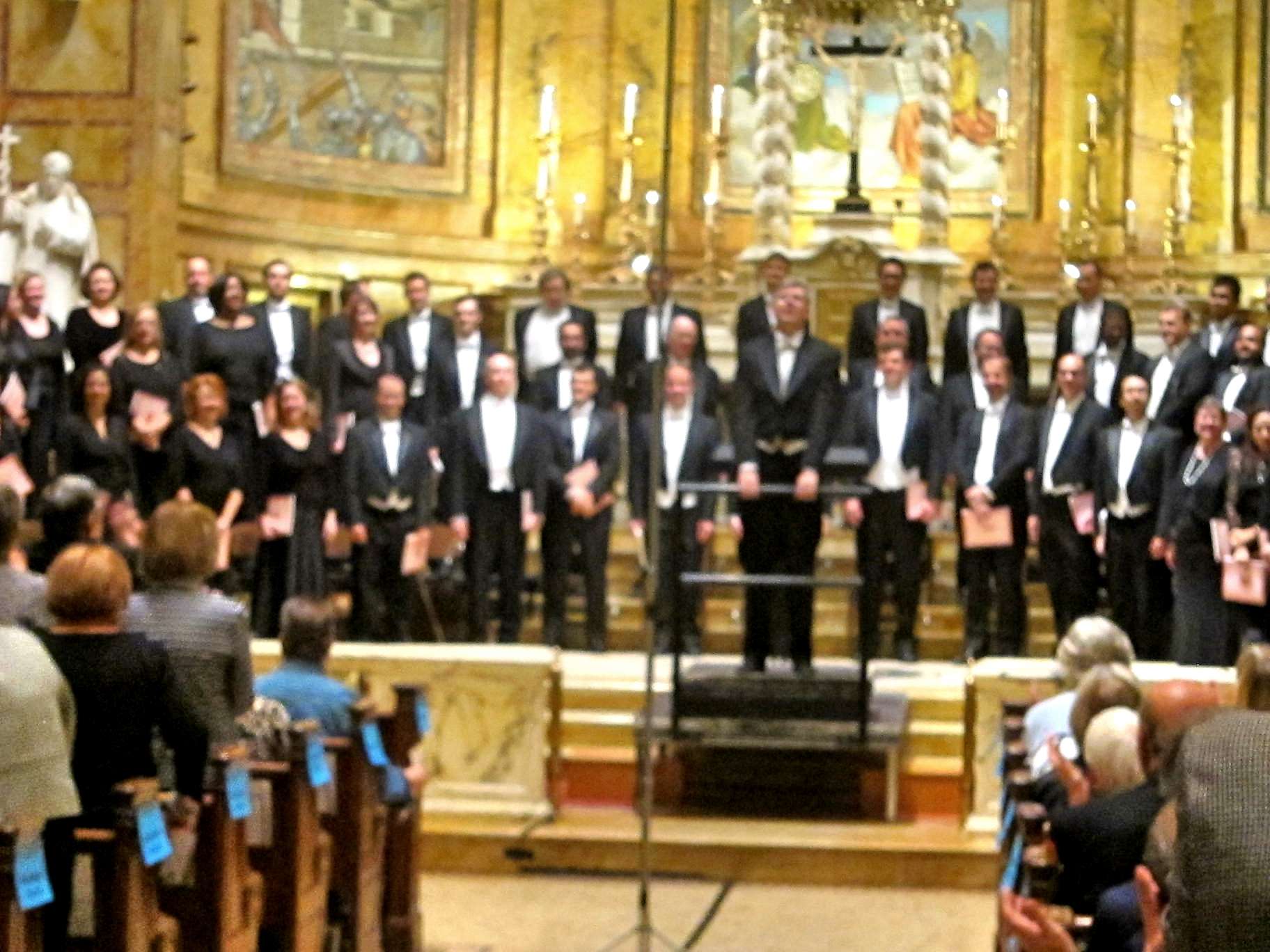|
Back
Attempting the Resplendent New York
St. Ignatius Loyola Church, 980 Park Avenue
10/16/2013 -
Sergei Rachmaninoff: All-Night Vigil (Vespers), Opus 37
Douglas Purcell (Tenor), Sara Murphy (Mezzo-soprano)
The Choir of St. Ignatius Loyola, Margery Daley (Choral Contractor), Mischa Fruztajer (Russian Diction Coach), K. Scott Warren (Artistic Director, Conductor)

The Choir of St. Ignatius Loyola (© Coco T. Dog)
Tuesday evening, Denis Matsuev, Valery Gergiev and the Mariinsky Orchestra showed two faces of Sergei Rachmaninoff: the virtuoso pianist and the orchestral pyrotechnician. Twenty-four hours later, the much rarer ecclesiastical Rachmaninoff was offered in an unlikely place.
The choral music was inspired by Rachmaninoff’s love of all things Slavic, especially the ancient chants of the Russian Orthodox Church. Taking these chants and re-composing them for full choir (the church never allowed in musical instruments, despite Psalm 150), Rachmaninoff produced a masterwork of the Eastern Church. Which was presented in a century-plus-old Roman Catholic Church.
But St. Ignatius Loyola Church physically does resemble an Eastern edifice. True, the pictures and ornaments are from the Western end. But glistening gold/yellow colors, the cupolas, the Moorish arches, the grand ceiling, all would signify a Byazntine church that could easily play host to Rachmaninoff’s choral work. True, you wouldn’t find women in the choir, and true, the church did not smell of incense doused out by the Official Censer. Other than that, this All-Night Vigil, which included verses from the Vespers was right at home.
The Choir of St. Ignatius Loyola gave it their all, aided by Russian diction coach Mischa Fruztajer, discipline by conductor K. Scott Warren and–most of all–the resonance coming from the spacious interior of the church. It was not their fault that, while the choir was excellent, one could never mistake it for the original Russian choirs which performed the work.
(As a footnote, the Russian Orthodox Church never performed the piece during the composer’s lifetime, since Rachmaninoff had been officially excommunicated for marrying a relative. On the other hand, the atheistic Soviet Russians published it in 1922, seven years after its composition.)
Listening to recordings of the All-Night Vigil, the basses are the bosses from the third measure on. Here, Mr. Warren aimed for a balance of voices. His first section was taken very slowly, as if to offer the supreme gravity of the work. But with the roll of the men’s voices, no slowing would have been necessary.
Yet one soon became accustomed to this “nice” way to sing the work, and one soon accepted that the women of the choir might shade the almost-impossible low B-flats of the baritones. We had a similar problem with Mezzo Sara Murphy in the second section. Her voice must stand totally apart from the dark choir accompaniment. Yet her marvelous air was simply part of the entire ensemble, never really the soloist.
There was no problem with tenor Douglas Powell. He stepped away from the choir in both the fifth and long ninth section, and the solos were most appealing.
We had moments of utmost beauty here. The sounds of choral bells in the seventh section, the crescendo and decrescendos of ”Alliluiya, Alliluiya, Alliluiya”, the chants at the start of the Ninth section. And then surprise, surprise, toward the end of the Ninth section, the chorus came close to the orchestral themes of the third Symphonic Dance played two nights ago. Though perhaps it wasn’t a surprise, as this could have been an original Russian chant, used in both works.
Those previous reservations are perhaps unwarranted, since the work itself is as gorgeous as the opulent settings of any Russian Orthodox church. Much is because, unlike the Western Church, where historical frictions, infighting and schisms enabled rebellious innovative composers to build their own musical monuments, the autocratic Eastern Church has preserved its medieval music to the present day. In fact, in a village Ethiopian church some years ago, I heard chanting which resembled the same lines as the work last night.
But at its best, a choir can bring forth a myriad of colors from the chants and complex harmonies. The Choir of St. Ignatius Loyola was not monochromatic, but there was a sameness of intent, a difference of volume and nuance but not of vocal color.
Rachmaninoff wrote religious music infrequently, so the All-Night Vigil is a true rarity. But he was a composer who could turn ritual into reverence, which he obviously did here. Yes, the great weight, the subterranean voices of Russia were rarely heard in this church. But the St. Ignatius Loyola Choir did give us a more than admirable approximation of an inward incorporeality. At times, in fact, it was actually transformed into a work which was both lush and mystical, wearing the resplendent apparel of a majestic, even spiritual artist.
Harry Rolnick
|